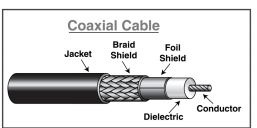If you are familiar with low voltage cables in anyway, you have heard of coaxial cable before and the cable's impedance. Two of the most commonly used that we will discuss more in this article are 50 ohm and 75 ohm and the shielding that is most commonly seen within them.
What is an Ohm?
An Ohm is the SI unit of electrical resistance that identifies the flow of electrical energy throughout the cable. An Ohm is defined as electrical resistance between two points of a conductor in the International Systems of Units (SI). The smaller the Ohm the cable has the better the performance will be.

- 50 Ohm: This coax cable is seen with commercial installations with cable running 100+ feet with square footage up to 100,000.50 Ohm cables are primarily used for high power handling capacity such has routers, radio/TV transmitters, Wi-Fi, ethernet networks, etc.
- RG58
- This cable generally acts as a generic carrier for low-power signals and RF connections.
- RG8
- Designed for carrying radio transmission signals. This cable is unable to carry pure video signals due to the design so it is typically used for radio signals.
- RG213
- Used in military and commercial applications and used within heat sensitive environments. Some of the applications may be used in radio communications, high-performance electrical, data transmissions, broadcast and computer applications.
- 75 Ohm: These are the standard coax cables that are found within homes and commercial properties. 75 Ohm cables are primarily used for AV signals and can transmit signals up to 50 ft with any installation. This cable can be commonly used for High Def TV signals, Satellite and Cable boxes and police scanners. 75 ohm also offers low attenuation and capacitance acceptance for these digital audio, A/V and data signals.
- RG59
- Used primarily for cable TV connections and are commonly seen in order home and commercial installations. The cable is thinner and is recommended in low bandwidth and frequency applications such as analog video and CCTV installations.
- RG6
- This cable is heavier gauge with insulation and shielding tuned for high-bandwidth, high-frequency applications such as: internet, cable TV, satellite TV signals.
- RG11
- Designed for long runs and are generally not used for any in-house cases. Generally this is also twice as thick as a standard coax cable.
Foil Shield- foil shields are made of thinner aluminum polyester film which allows for 100% coverage within construction. This type of shielding is very good for radio frequency (RF) but is not ideal for blocking Electro Magnetic Inferences (EMI). This type of shielding is ideal for low cost protection.
BiFoil- This form of shielding allows for an added layer of protection within increasing the metallic coverage while still maintaining a thinner diameter of the cable.
Bonded BiFoil- This type of shield is similar to the bi-foil but it is bonded to the dielectric with an adhesive which allows for better shielding and ease of stripping/termination.
Braid Shield- This type of shield can be constructed in various ways. This material can be bare copper, tinned copper or aluminum. They can reduce the EMI Interference but are not as effective in RF ranges.
Combination Shielding- Offers the best of both types of shielding. First a foil shield is applied around the dielectric and then a braided shield is placed on top of the foil shield. This allows for greater amounts of coverage with EMI and RFI signals.
What to learn more about low voltage pre-terminated coax cables in particular?
Click on the following link:


